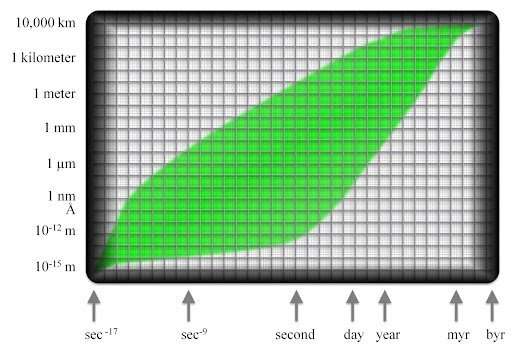'Nature's Envelope': A simple device that reveals the scope and scale of all biological processes

As biology is progressing into a digital age, it is creating new opportunities for discovery.
Increasingly, information from investigations into aspects of biology from ecology to molecular biology is available in a digital form. Older "legacy" information is being digitized. Together, the digital information is accumulated in databases from which it can be harvested and examined with an increasing array of algorithmic and visualization tools.
From this trend has emerged a vision that, one day, we should be able to analyze any and all aspects of biology in this digital world.
However, before this can happen, there will need to be an infrastructure that gathers information from ALL sources, reshapes it as standardized data using universal metadata and ontologies, and made freely available for analysis.
That information also must make its way to trustworthy repositories to guarantee the permanent access to the data in a polished and fully suited for re-use state.
The first layer in the infrastructure is the one that gathers all old and new information, whether it be about the migrations of ocean mammals, the sequence of bases in ribosomal RNA, or the known locations of particular species of ciliated protozoa.
How many of these subdomains will be there? To answer this, we need to have a sense of the scope and scale of biology.
With "Nature's Envelope" we have, for the first time, a simple model that depicts the scope and scale of biology. Presented as a rhetorical device by its author Dr. David J. Patterson, University of Sydney, Australia, Nature's Envelope is described in a Forum Paper, published in the open-science journal Research Ideas and Outcomes (RIO).
This is achieved by compiling information about the processes conducted by all living organisms. The processes occur at all levels of organization, from sub-molecular transactions, such as those that underpin nervous impulses, to those within and among plants, animals, fungi, protists and prokaryotes. Further, they are also the actions and reactions of individuals and communities; but also the sum of the interactions that make up an ecosystem; and finally, the consequences of the biosphere as a whole system.
In Nature's Envelope, information on sizes of participants and durations of processes from all levels of organization are plotted on a grid. The grid uses a logarithmic (base 10) scale, which has about 21 orders of magnitude of size and 35 orders of magnitude of time. Information on processes ranging from the subatomic, through molecular, cellular, tissue, organismic, species, communities to ecosystems is assigned to the appropriate decadal blocks.
Examples include movements from the stepping motion of molecules like kinesin that move forward 8 nanometers in about 10 milliseconds; or the migrations of Arctic terns which follow routes of 30,000 km or more from Europe to Antarctica over three to four months.
The extremes of life processes are determined by the smallest and largest entities to participate, and the briefest and most enduring processes. The briefest event to be included is the transfer of energy from a photon to a photosynthetic pigment as the photon passes through a chlorophyll molecule several nanometers in width at a speed of 300,000 km per second. That transaction is conducted in about 10-17seconds. As it involves the smallest subatomic particles, it defines the lower left corner of the grid.
The most enduring is the process of evolution that has been progressing for almost 4 billion years. The influence of the latter has created the biosphere (the largest living object) and affects the gas content of the atmosphere. This process established the upper right extreme of the grid.
All biological processes fit into a broad S-shaped envelope that includes about half of the decadal blocks in the grid. The envelope drawn round the initial examples is Nature's Envelope .
"Nature's envelope will be a useful addition to many discussions, whether they deal with the infrastructure that will manage the digital age of biology, or provide the context for education on the diversity and range of processes that living systems engage in. The version of Nature's Envelope, published in the RIO journal, is seen as a first version, to be refined and enhanced through community participation," says Patterson.
More information: David Patterson, The scope and scale of the life sciences ('Nature's envelope'), Research Ideas and Outcomes (2022). DOI: 10.3897/rio.8.e96132
Provided by Pensoft Publishers


















